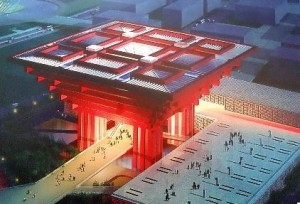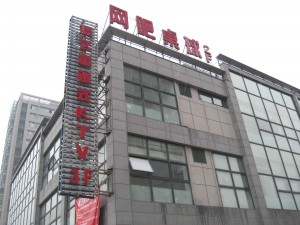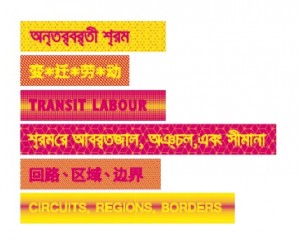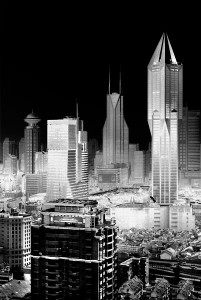Total EXPOsure: World’s Fairs and Other Futuristic Spectacles in the U.S. and China from the 1870s to 2010: A Dialog with Jeff Wasserstrom and Nick Land 21 June, 2010 No Comments

Jeffrey Wasserstrom is an urban historian, blogger for “The China Beat,” frequent contributor to newspapers and magazines (including Time), and the author, most recently, of the books Global Shanghai,1850-2010 (2009), and China in the 21st Century: What Everyone Needs to Know (2010). His comments will focus on placing the Shanghai Expo into the World’s Fair lineage, which stretches back to the Crystal Palace Exhibition of 1851 and includes major events, like the Chicago Columbian Exposition of 1893, that took place while the United States was rising rapidly in the global hierarchy and becoming a source of international fascination and concern, much as China is doing today. He will also talk about links between the city of Shanghai, World’s Fairs, and science fiction.
China’s Many Internets: Participation and Sites of Digital Game Play Across a Changing Technology Landscape 29 May, 2010 No Comments
Seminar
Presenter: Marcella Szablewicz
Date: Saturday 29 May, 2010
Time: 2-4pm
Venue: Xindanwei, 4C, Bld 4 in Shanghai Hub No. 727 Dingxi Lu, Changning
 Abstract:
Abstract:
Silvia Lindtner and Marcella Szablewicz have conducted ethnographic research on digital gaming practices in urban China over the last 6 years. Digital games are not only inherently participatory but are also one of the most popular forms of Internet technology in China today, and as such they are particularly illustrative examples of relations between technological practice and social and economic change in China more broadly. Lindtner and Szablewicz’s research reveals how urban youths and young professionals in China utilize digital games to position themselves and form new identities amidst urban China’s rapid economic and technological transformations. Two main points emerge: First, digital participation is not confined within a single software application, but is a contingent process evolving in relation to wider social, economic and political developments in China. Second, digital games in China are a means by which young Chinese engage with and express ideas about social belonging, identity and class.
Bio:
Marcella Szablewicz is a PhD Candidate at the Department of Language, Literature and Communication at Rensselaer Polytechnic Institute. She is spending the year in Shanghai on a U.S. Fulbright Fellow and is working as a visiting scholar at the Shanghai Academy of Social Sciences.
Platform as Method: Strategies for Counter-Cartographic Research in Beijing, Ningbo and Shanghai 19 April, 2010 No Comments
Seminar
以平台为方法:在北京,宁波和上海反制图研究的策略
Presenter: Ned Rossiter
Date: Sunday 25 April, 2010
Time: 2-4pm
Venue: Xindanwei, 4C, Bld 4 in Shanghai Hub No. 727 Dingxi Lu, Changning

Abstract
Platforms organize. They bring bodies and brains into relation. While they require highly distributed formats of digital communication and translation, platforms must connect with off-line worlds. Practices of collaborative constitution hold a generative capacity that invent new institutional forms. When multiplied across time and space, platforms connect seemingly disparate events along circuits of experience and experimentation. The work of platforms at once tests and produces concepts. Platforms address contingency and movements as constitutive methods of analysis and organization.
This paper asks how the organization of platforms can serve as a research tool and method for transcultural mapping in urban settings. Taking examples from urban research projects in Beijing, Ningbo and Shanghai, the paper investgiates how the city becomes the site of a research platform that combines online and offline methods to gather researchers from across the world and bring them into collaborative relation with local participants through workshops, site visits, symposia, exhibitions, mailing lists, blogs and publishing. The aim is to flee the data-mined, self-referential universe of social networking sites by building a multilingual environment for collaborative invention and the common production of knowledge.
简介
平台组织。他们联系着机构团体和智力因素。然而,他们需要数字化通讯和翻译的高度分布,平台必须连接着离线的世界。协作性章程的实践含有一种创造新体制形式的生成能力。当平台的增多穿越时间和空间,平台连接着经验和实验,这两条看似背道而驰的事件的线路。当下平台的工作测验和产生着概念。平台将偶然发生的事件和运动比作分析和组织的构成方法。
这份报告提出平台机构作为调研工具和方法,如何服务于在城市环境中进行的绘测工作。以在北京,宁波和上海的城市研究课题为例,这份报告调查了城市是如何成为研究平台的场所,这个场所结合了联机和脱机的方法,将全球的研究者聚集在一起,和当地的参与者形成涉及工作车间、实地考察、专题研讨会、公开展览,邮件列表,博客,出版的合作关系。报告旨在通过为合作发明和知识的共同生产建立一个多语言的环境,远离数据开采和自我参照的社会网络站点宇宙。
Bio
Ned Rossiter is an Australian media theorist and Associate Professor of Network Cultures, University of Nottingham, Ningbo, China and Adjunct Senior Research Fellow, Centre for Cultural Research, University of Western Sydney, Australia. He is author of Organized Networks: Media Theory, Creative Labour, New Institutions (2006) and co-editor of numerous volumes, including (with Geert Lovink) MyCreativity Reader: A Critique of Creative Industries (2007).
http://orgnets.net / http://nedrossiter.org
主讲人介绍
Ned Rossiter 是澳大利亚的一位媒体理论家,中国宁波诺丁汉大学网络文化学副教授以及澳大利亚悉尼西部大学文化调研中心的兼职高级研究员。他是 Organized Networks: Media Theory, Creative Labour, New Institutions (2006)的作者。他与 Geert Lovink 合作编辑了 MyCreativity Reader: A Critique of Creative Industries (2007). http://orgnets.net / http://nedrossiter.org
Waste Economies: Mapping Formal and Informal Waste Infrastructures in Shanghai 21 March, 2010 No Comments
Seminar
Presenters: Maren Koehler and Bettina Vismann
Date: Saturday 27 March, 2010
Time: 2-4pm
Venue: Xindanwei, 4C, Bld 4 in Shanghai Hub No. 727 Dingxi Lu, Changning
Abstract
This project investigates the organizational and spatial dimensions of waste, with a special focus on the collection of urban waste and processes of selection for recycling. In Shanghai the treatment of municipal waste is an everyday routine. Alongside official procedures for waste management, lateral networks with high flexibility and efficiency have developed. The system of interconnected scavengers, selectors and street cleaners is made visible when spatially registered. A street corner, a wastebin, a collection depot become temporary nodes of exchange.
Our investigation of the logistics of municipal waste and its attendant economies is made accessible by combining drawing techniques with photography. In this seminar we discuss the discrepancies between formal and informal uses of public space and waste as they connect with different modes of self-organized labour.
The study of waste in Shanghai is part of a broader analysis conducted in Eastern and Western Europe.
Bio
Maren Koehler (Shanghai) and Bettina Vismann (Berlin) are both trained as architects. In the past 10 years they have collaborated on projects combining research, architectural practice and academic teaching.
Shanghai: City of Tomorrow? 13 December, 2009 No Comments
Seminar
Presenter: Anna Greenspan
Date: Saturday 19 December, 2009
Time: 2-4pm
Venue: Xindanwei, 4C, Bld 4 in Shanghai Hub No. 727 Dingxi Lu, Changning
 Abstract
Abstract
Modernism’s alchemistic promise has been a failure, a hoax: magic that didn’t work. Its ideas, aesthetics, strategies are finished. Together, all attempts to make a new beginning have only discredited the idea of a new beginning. – Rem Koolhaas S,M,X,XL (1995)
Touch the Future – Slogan on a Shanghai billboard advertising the 2010 World Fair
In much of the Western world the future now belongs to the past. The very idea of the city of tomorrow – with its multilayered skyways, housecleaning robots and flying cars – seems doomed to the realm of nostalgia, the sadly comic promise of a future that never arrived.
Today – much to the alarm of opinion makers in America – this future is resurfacing in Shanghai. It is most apparent in the science fiction skyline, which functions as an Illuminated ad for itself – the deliberate showcase of an approaching urban destiny.
Yet, this economy of anticipation is evident far beyond the city’s most famous icon. On the periphery, in the satellite ‘new towns’ the gardens are manicured and the guard booths are manned, but the streets and squares stand empty. Signs – built long before their destinations – point to markets, schools and hotels that do not yet exist. Closer to the city center, remnants of an industrial past are being transformed into ‘creative clusters’. Disused factories and warehouses – now gutted and wrapped in glass – seek to unlock the city’s creative potential. In a metropolis of close to 20 million people, these abandoned places seem eerie, like ghost towns lying in wait, haunted by those who have yet to arrive.
Of even greater concern to the columnists of New York Times and Newsweek is that these physical manifestations are coupled with a palpable optimistic energy, or to use David Brooks’ formulation, an ‘eschatological faith in the future’. Faced with unprecedented urbanization and runaway technological growth, China’s giant metropolis has responded– like the cities of the industrial age – with a confidence in science and technology, a positive belief in progress and a hopeful – even exultant – futurism.
My work explores this new futurism as it emerges in Shanghai .
It does so, first, by examining Shanghai’s ambitions for the 21st century alongside the 20th century project of imagining, planning and building a future Metropolis. With its skyscrapers, satellite towns, networks of subways and labyrinthine overpasses that are currently under construction, Shanghai is creating the retro-futurist monuments to a new modernity. This project receives its most overt expression in the approaching 2010 world fair, which explicitly seeks to reanimate the great exhibitions of a previous age.
In mapping the ‘City of Tomorrow’ as it resurfaces in a new time and place, my work asks whether the same dynamic that eclipsed yesterday’s dreams of a future metropolis in the West is fated to replay itself in Shanghai. Or, whether, instead, Shanghai might produce its own unexpected and alternative (neo)modernity .
In searching for the contours of this new – and unfamiliar – futurism, my work looks for the foreshadowing of a creative epoch that is unique to Shanghai, one that is based not only in the spectacle, visions and plans that come ‘from above’ but also in the shadowy world of unintended, unanticipated innovation out of which the future will undoubtedly arise.
Bio
Anna Greenspan received her PhD on the relationship between the technology and philosophy of time in conjunction with the cybernetic culture research unit at the University of Warwick, UK. Her postdoctoral research resulted in a book on India and the IT industry. Anna has been based in Shanghai for most of the decade and now teaches and writes on the city’s dynamic growth. Anna maintains a website at www.wakinggiants.net
Designing Creative Clusters 3 November, 2009 No Comments
Seminar
Presenter: Professor Justin O’Connor (Queensland University of Technology)
Date: Saturday 7 November, 2009
Time: 2-4pm
Venue: Xindanwei, 4C, Bld 4 in Shanghai Hub No. 727 Dingxi Lu, Changning
Abstract
Clusters of diverse creative businesses are increasingly important for creative industries and urban policy makers across the globe. Traditionally seen as ‘organic’, because of the pressures on urban real estate and the increased centrality of these industries to the cultural economy of cities, they are now increasingly being set up by city governments and the private sector. To plan and design such clusters in way that responds to the needs of these businesses, and the dynamics of the urban cultural economy, we need a much better understanding of how they work. The success of creative clusters depends as much on their ‘soft infrastructure’ (networking, knowledge, human capital, sense of identity etc.) as on their ‘hard infrastructure’. A crucial addition to this soft infrastructure are new forms of digital networking, advanced workspace design, urban screens and other kinds of digital place- making – all of which build on the fluid, face-to-face interaction of physical space.
Aesthetics of Contact and Mobility in an era of Global Crisis Management 28 September, 2009 No Comments
Seminar
Presenters: Gillian Fuller and Ross Harley
Date: 11 October 2009
Time: 2-4pm
Venue: Xindanwei, 4C, Bld 4 in Shanghai Hub No. 727 Dingxi Lu, Changning
Abstract
Discourses of contagion, containment, crisis and immanent disaster are part and parcel of contemporary airport logistics. Recent scares over SARS, avian and swine flu highlight the wide variety of biometric and logistical techniques for managing urban/epidemic crisis. We argue that these techniques apply not only to liminal zones such as airport terminals, but also to the broader urban fabric of everyday life. The intimate relations of architecture and information in the global space of flows raises a set of questions around the aesthetics of touch and intimacy associated with communication networks of all kinds. The relationships between architecture, movement and the city have long been discussed in terms of regimes of vision — e.g. the ‘panoramic’ or the ‘cinematic’ city. This presentation tracks a genealogy/topology of mobile concepts, techniques and aesthetics located within the invisible waves of radio and an emergent logic of touch around ‘contactless technologies’. Our discussion will focus on implications of ubiquitous networks of mobile telephony, rfid tagging, bluetooth, wifi, and a multitude of other wireless technologies that penetrate the surfaces of bodies, the walls of buildings and that guide and track objects in motion.
About Fuller + Harley
Fuller + Harley are an interdisciplinary research-production team who fuse new media theory and practice in a variety of formats. For the past five years, they have been working on a multi-modal project that analyses the flows and network spaces of contemporary airports. Gillian Fuller, who trained as a semiotician and now specialises in new media geographies and mobile cultures, has worked in museums, and published in journals such as Borderlands, Fibreculture Journal and Social Semiotics and is co-editing the forthcoming book, Stillness in a Mobile World for the International Library of Sociology Series (Routledge). Ross Rudesch Harley is an artist and writer whose media work has been exhibited in venues such as at the Pompidou Centre, New York MoMA, Ars Electronica, and the Sydney Opera House. His writing has appeared in Art + Text, Convergence, Screen, Rolling Stone and The Australian. Their recent work, Aviopolis: A Book about Airports was published by Black Dog Publishing, London, in 2005. They are both researchers at the University of New South Wales, Sydney. For further information about their work, visit aviopolis.com, stereopresence.net and transitsemiotics.org.

